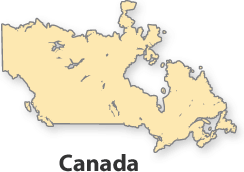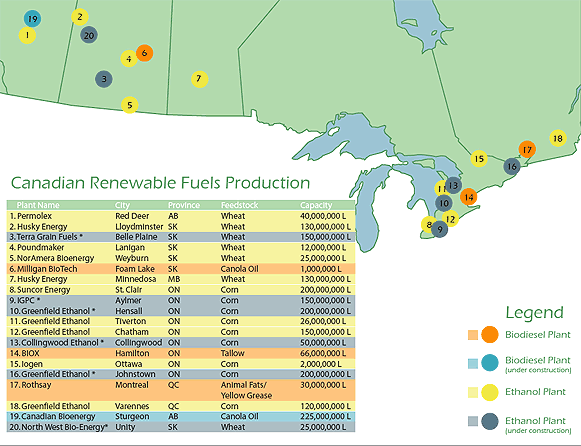Canada Biofuels Activities

Here you'll find information about Canada's work in biofuels. Learn more about its:
Background
Unlike some other economies, energy security is not a factor driving the biofuels development in Canada. Canada has the world's second-largest proven oil reserve (estimated at 178.3 billion barrels) and is one of the top 10 oil-exporting countries in the world. However, Canada is committed to diversifying its energy portfolio with cleaner, renewable fuels such as ethanol and biodiesel.
Production
Ethanol production in Canada (all grades) was estimated at 569 million liters in 2006, with the potential to grow to 1,000 million liters in 2007 after new biorefineries came online. It is unknown what percentage of this production was dedicated to fuel use. However, previous studies estimated that fuel ethanol accounted for two-thirds of total ethanol production in 2005. The Canadian Renewable Fuels Association (CRFA) reports that there are 10 existing ethanol plants (715 million liters total capacity) and six are under construction (880 million liters). The province of Ontario accounts for about half of Canada's ethanol production.
The company Iogen Corp. maintains a demonstration plant for producing ethanol from cellulose in Ottawa, but this plant produces demonstration, not commercial, quantities of cellulose ethanol.
Starting in late 2005, production of biodiesel was estimated at 47 million liters for 2006. There are three existing production facilities with a total capacity of 96 million liters per year. Biodiesel Magazine reports one plant under construction in Arborg, Manitoba, with 4 million liters capacity.
Figure 1. Canada Renewable Fuels Production

Source: Canadian Renewable Fuels Association
Feedstock
In Canada, ethanol is produced almost entirely from cereals (corn and wheat). Corn accounted for 77% of all ethanol feedstock in 2006. This percentage is expected to decrease as more wheat-based plants come online (USDA). Corn production was about 9 million tonnes in 2006, 7% of which was used for ethanol production. The majority of domestically produced and imported corn is used by the livestock industry.
Wheat production in Canada is much higher, more than 20 million tonnes annually. Being the world's second-largest exporter of wheat (after the United States), the majority of this production goes for export (about 17 million tonnes annually). Less than 1% was used for ethanol production in 2006.
With its vast forest and agricultural resources, Canada has a great potential for cellulosic ethanol production. In the agricultural sector, prairie grain crops produce an estimated 32 million tonnes of straw residue per year. If 85% of that straw must be put back into the soil to maintain fertility, approximately 5 million tonnes would be available to make biofuels. Canada has millions of hectares of managed forests, and much of the forest residue is not used and often is sent to a landfill or incinerated.
Biodiesel in Canada is produced from animal fats, recycled cooking oils, and canola. The Canadian rendering industry produces about 400,000 tonnes of animal and yellow grease annually for the oleochemical and animal feed industry. Canola is Canada's dominant vegetable oil (grown annually on approximately 13 million acres), and the sheer size of the annual crop makes it easy to supply the biofuel market. Currently, about 80% of Canada's annual canola production is exported. About 1 million tonnes of canola would be needed to meet the 2% biodiesel target set by the government. Last year alone, the industry's carry-over — or unsold volumes that stayed in storage bins — was 1.5 million tonnes. However, increasing feedstock prices are a concern for the biodiesel industry. Canola is priced high as oil for human consumption, while yellow grease and animal fats are priced as residual oils for feed and industrial use.
Estimates by the Canadian Canola Growers Association show a potential of 500 million liters of biodiesel in the 2007-2010 time frame. This potential is broken down as follows: 160 million liters from tallow, 80 million liters from yellow grease, 220 million liters from canola, and 40 million liters from soybeans.
Economics
The following charts show specific economic statistics for the member economy.
| Ethanol | CAN$/liter |
|---|---|
| From grains | 0.36 - 0.46 |
Source: Canadian Renewable Fuels Association 2006
| Biodiesel | CAN$/liter |
|---|---|
| From yellow grease | 0.48 |
| From tallow | 0.61 |
| From canola oil | 0.81 |
Source: Canadian Canola Growers Association 2006
Biofuels in Use
E5 (a blend of 5% ethanol with petroleum) is sold in Ontario, E7.5 in Saskatchewan, and E8.5 in Manitoba. E85 is mostly used by the fleets of Natural Resources Canada (NRC).
Biodiesel in low blends (B2 and B5) has been used by government and private fleets all across Canada. B20 is used by Terminal Systems Inc. (the largest container terminal operator in Canada) in all equipment and vehicles with diesel engines.
Infrastructure and Vehicles
In Canada, there are about 1,000 service stations offering ethanol-blended gasoline at blends varying from 5% to 10% ethanol, depending on the retailer and provincial requirements.
UPI Energy opened the first E85 retail pumps in Canada in 2007 – one in Guelph, Ontario, and another in Chatham, Ontario. NRC has one of the few private E85 refueling stations feeding a fleet of departmental cars.
No statistics are available on the number of flexible fuel vehicles (FFVs) on the roads in Canada.
Trade
There is no official data available for either fuel ethanol or biodiesel trade. However, statistics show that Canada imported about 100 million liters of total ethanol (all grades – potable and denatured) in 2006, exclusively from the United States. Several Canadian companies import biodiesel from the United States as well.
Under the North American Free Trade Agreement (NAFTA), there is a free trade of renewable fuels among the United States, Mexico, and Canada. However, Canada has a tariff on ethanol imported from Brazil ($0.05 per liter).
Policy
In July 2007, the Canadian government announced that it would provide up to $1.5 billion in incentives over nine years to producers of renewable alternatives to gasoline and diesel fuel. The incentives are primarily for producers to "bridge the gap" between the current production level and the 3,000 million tonnes/year that will be needed to meet the 2012 targets, which were set by the government in December 2006. Essential elements of the new energy policy include:
- Reaching an average of 5% renewable content in gasoline by 2010 and 2% renewable content in diesel fuel and heating oil by 2012.
- Federal incentives provided through excise tax exemptions, amounting to $0.10 per liter for ethanol and $0.04 per liter for biodiesel.
- A National Biomass Expansion Program providing $140 million in contingent loan guarantees to encourage financing for new plants that produce ethanol from biomass material such as crop residues.
Government Programs
The eco Agriculture Biofuels Capital Initiative (ecoABC) is a federal $200 million, four-year capital grant program that provides funding for the construction or expansion of transportation biofuel production facilities. It appears funding is focused on cellulosic ethanol.
On July 5, 2007, Prime Minister Stephen Harper announced the ecoENERGY for Biofuels Initiative, which will invest up to $1.5 billion over nine years to boost Canada's production of biofuels.
The ecoAUTO Rebate Program encourages Canadians to buy fuel-efficient vehicles, including FFVs. It offers rebates from $1,000 to $2,000 to people who, beginning March 20, 2007, buy or enter a long-term lease (12 months or more) for a fuel-efficient vehicle.
Several Canadian provinces have additional policies and incentives:
- Ontario's regulation requires an average of 5% ethanol in gasoline and went into effect in January 2007. Ontario announced in June 2006 that it was phasing out its road tax exemption and replacing it with the Ethanol Growth Fund intended to provide ethanol production incentives of $520 million over 12 years.
- Saskatchewan's 7.5% ethanol requirement in gasoline took effect in October 2006. Saskatchewan also offers a distributor tax credit for ethanol of up to $0.15 per liter, provided that ethanol is produced and consumed in the province.
- Manitoba has passed legislation requiring 10% ethanol content in 85% of the province's fuel, but has not yet set a date for entry into force. Manitoba offers a provincial tax credit of $0.25 per liter for fuels containing at least 10% ethanol (provided the fuel is produced and consumed in Manitoba), as well as a $0.115 per liter tax exemption for biodiesel.
- Quebec has set a goal of 5% ethanol in gasoline by 2012 and expects that target to be met by next-generation cellulosic ethanol. Quebec provides an income tax credit for ethanol producers that produce and sell in Quebec. Quebec also offers reimbursement of fuel taxes paid on the purchase of biodiesel.
- British Columbia has road tax exemptions for ethanol and biodiesel of $0.145 and $0.150 per liter, respectively. The BC Energy Plan, announced in August 2007, will implement a 5% average renewable fuel standard for diesel by 2010 and will increase the ethanol content of gasoline to 5% by 2010.
- Alberta announced a Bio-Energy Program in October 2006 that replaced its provincial ethanol road tax exemption and allocates $209 million over four years to renewable fuels, and $30 million for commercialization support. It includes a Bio-Energy Producer Credit program, a Bio-Refining Commercialization and Market Development Program, and the Bio-energy Infrastructure Development Program.
Sources
- Natural Resources Canada
- Canadian Canola Growers Association
- Canadian Renewable Fuels Association
- Canola Council of Canada
- Biodiesel Association of Canada
- Transport Canada
- The Office of Energy Efficiency (OEE)
- Biodiesel magazine
- Ethanol Producer magazine
- U.S. Department of Agriculture (USDA), GAIN Report 2007 (PDF 204 KB) Download Adobe Reader.